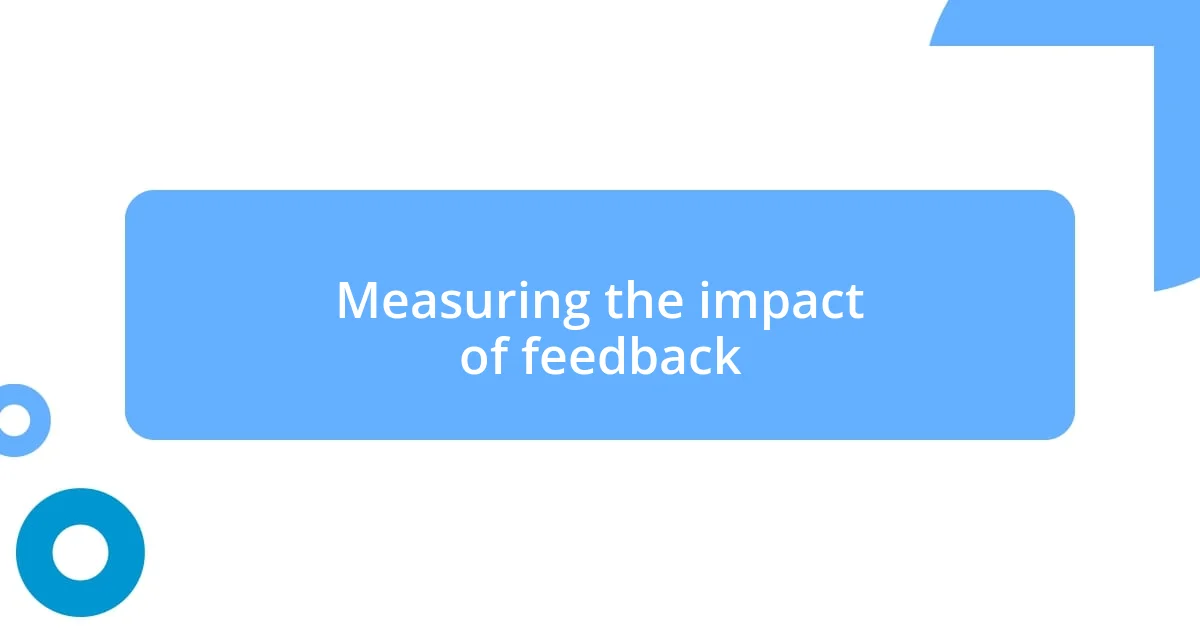Key takeaways:
- Social media feedback significantly influences self-perception and content strategy, emphasizing the importance of understanding audience preferences.
- Engaging thoughtfully with feedback, such as acknowledging comments and asking questions, can turn criticism into constructive dialogue and strengthen community connections.
- Leveraging feedback for content improvement leads to greater audience engagement and encourages creators to experiment and adapt their styles based on audience reactions.

Understanding social media feedback
Social media feedback can be both a blessing and a bane. I remember posting a creative piece I was really passionate about; the comments ranged from praise to harsh criticism. It struck me how deeply these responses affected my mood—do they define my worth as a creator? This rollercoaster of emotions really highlighted to me the power of feedback in shaping our self-perception.
Diving into the analytics of my posts, I learned that social media feedback isn’t just black and white; it’s nuanced. Sometimes it feels overwhelming to sift through the noise, but analyzing patterns in feedback can reveal what resonates with my audience. For instance, when I saw that my audience loved personal stories, it made me rethink how I share experiences. Could I have embraced vulnerability sooner?
It’s fascinating how quickly social media feedback can influence trends and opinions. I’ve watched my peers shift their content strategies based on responses. When I took the plunge to engage directly with my audience’s feedback, I found that creating a dialogue fostered a sense of community. I realized then that social media isn’t just about sharing; it’s about connecting and evolving together.

Analyzing feedback patterns and trends
Analyzing feedback patterns on social media has opened my eyes to recurring themes that often go unnoticed. For example, I once received a wave of comments about my use of humor in posts. Initially, I dismissed these insights as ephemeral, but after reflecting on similar feedback over time, it became clear that this light-hearted approach was something my audience treasured. I began to wonder—what if I had taken this feedback seriously from the start?
What surprises me is how seemingly small shifts in wording or imagery can lead to vastly different reactions. I remember one post where I shared a simple anecdote about a day trip, and the engagement soared compared to a more polished piece on productivity. It struck me that authenticity often wins over perfection. It begs the question: do we sometimes overthink what we share? The more I analyze these trends, the more I understand the significance of being genuine and relatable.
I’ve noticed that feedback isn’t just about what’s said; it’s also about the emotional resonance behind it. There were times I received critical feedback that felt personal but, when analyzed, revealed constructive points that helped me grow. It’s an emotional journey for sure, but embracing this process allows me to adapt and improve continuously, transforming what could have been hurtful into a powerful tool for growth.
| Feedback Type | Impact on Content Strategy |
|---|---|
| Positive Reinforcement | Encourages similar future posts |
| Constructive Criticism | Motivates content adjustments |
| Negative Feedback | Prompts a reevaluation of approach |

Strategies for responding to feedback
Strategies for responding to feedback can significantly shape your social media presence. I’ve found that taking a moment to pause before responding often leads to a more thoughtful engagement. Recently, I received a harsh comment that initially stung. Instead of firing back, I reflected on it for a few hours. When I finally replied, I acknowledged their perspective, which ended up diffusing the tension and even led to a constructive discussion.
Here are some strategies I’ve successfully used in my own experience:
-
Acknowledge the Comment: Show appreciation for the feedback, even if it’s not positive. This simple act can pave the way for a more productive dialogue.
-
Ask Questions: If feedback is vague or surprising, don’t hesitate to ask for clarification. Questions can turn a critical comment into a richer conversation.
-
Share Your Perspective: Explain your thought process behind the content without being defensive. I once shared insight about a post that someone criticized, turning their critique into an opportunity for connection.
-
Stay Positive: Maintaining a positive tone can transform a potentially negative exchange into a constructive experience.
-
Let It Go: Not all feedback warrants a response. Sometimes, it’s best to move forward and keep creating.
Engaging with feedback thoughtfully not only enriches your content strategy but also deepens the connection with your audience. I’ve learned that responding with empathy and openness can turn skeptics into supporters.

Leveraging feedback for content improvement
Leveraging social media feedback for content improvement can transform the way we connect with our audience. I remember a time when I shared a tutorial and received comments about its complexity. Initially, I felt discouraged, thinking I had failed to convey my message. However, upon reflection, I realized that this feedback allowed me to simplify my content, making it more accessible and engaging for everyone. Can you believe what a difference it made?
When I adjusted my approach based on this feedback, the engagement skyrocketed. My followers began to share their thoughts about how much easier it was to follow along. By being receptive to their input, I didn’t just improve that particular post; I’ve changed my entire mindset about creating content. I began actively seeking out feedback, and every constructive critique became a stepping stone for my growth. Wouldn’t it be amazing if we embraced feedback as a catalyst for creativity rather than a setback?
I’ve also learned the value of experimenting with different content styles based on audience reactions. Once, I shifted from writing long-form articles to creating bite-sized posts, inspired by suggestions from followers who preferred brevity. The results were staggering! Interactions surged, and I started to feel more in tune with what my audience wanted. By leveraging their feedback, I didn’t just refine my content—I sparked a new phase of inspiration and connection in my online community. It’s a powerful reminder that our audience often holds the keys to improvement.

Measuring the impact of feedback
Measuring the impact of feedback can be quite enlightening. I recall a time I implemented a feedback survey after a series of posts. The responses revealed not just satisfaction levels but deep insight into what my audience valued the most. That’s when I realized feedback is like a mirror, reflecting areas where I could grow and improve.
Analyzing the feedback helped me to quantify my audience’s preferences, which I found eye-opening. For instance, a simple thumbs-up or down couldn’t capture the nuance in people’s opinions. Diving into comments revealed trends and patterns I hadn’t noticed before. I remember a particularly enthusiastic response where a follower described how a specific series of posts had shifted their perspective—moments like that made me see the true weight of engagement beyond mere numbers.
It’s essential to track the outcomes of these adjustments. After changing my content strategy based on feedback, I experienced increased interaction and shares. Have you ever noticed how one tweak can garner a flood of new followers? Each positive metric validated the importance of listening to my audience, cementing the idea that feedback isn’t just a nice-to-have; it’s a powerful tool for growth and connection.












